
Station Name: LIVERPOOL CENTRAL HIGH LEVEL
|
| Date opened: | 2.3.1874 |
| Location: | At the junction of Ranelagh Place & Bold Street |
| Company on opening: | Cheshire Lines Committee |
| Date closed to passengers: | 17.4.1972 |
| Date closed completely: | 17.4.1972 |
| Company on closing: | British Rail (London Midland Region) |
| Present state: | Extensive sections of the station’s walls can still be seen behind the present Central station. The former station parcels office on Bold Street is extant and in use as a coffee bar. |
| County: | Lancashire |
| OS Grid Ref: | SJ350902 |
| Date of visit: | June 1968, 2005, 1.3.2009 & 22.7.2011 |
|
Notes: Liverpool Central station was the western terminus of the Cheshire Lines Committee’s (CLC) main line that linked the northern cities of Liverpool and Manchester. The CLC was a joint company made up of three partners: the Great Northern Railway (GNR), the Manchester, Sheffield & Lincolnshire Railway (MS&LR) and the Midland Railway (MR). The CLC’s Liverpool and Manchester line had opened as a through route between Cornbrook East Junction (Manchester) and Cressington Junction (Garston) on 2 September 1873. The line linked with the former Garston & Liverpool Railway at Cressington. The Garston & Liverpool had opened from Garston to a terminus at Liverpool Brunswick on 1 June 1864. It was a joint railway of the GNR and MS&LR that became part of the CLC on 5 July 1865.
At the eastern end of the line at Manchester there was a connection with the Manchester South Junction and Altrincham Railway (MSJ&AR) that allowed trains to run to Manchester London Road. Liverpool Brunswick station was over a mile south of the centre of Liverpool and therefore inconvenient for passengers. Just over a month after it opened an Act was obtained by the partners on 29 July 1864 to build a line called ‘The Liverpool Central Station Railway’. The line was one mile and forty-three chains in length, and to reach central Liverpool it needed five tunnels and sections of very deep cuttings. There were two stations on the line, St James and Liverpool Central. Due to the heavy engineering required the new line and Liverpool Central did not open until 2 March 1874. Being a relative latecomer to Liverpool the CLC had to make do with a cramped site but in the heart of the city’s shopping district; nevertheless the CLC built an imposing station which served as their headquarters.
Part of the open area at the front of the main station building was sheltered by a large canopy. On the western side of the building an access road for vehicles passed directly into the station. The station also had an entrance on Bold Street with a two-storey sandstone structure in the same style as the other buildings.
At the southern end of the station site, sandwiched between the platform 1 track and the western boundary wall, was the wooden Liverpool Central signal box. It opened before services started on 25 February 1874. The main lines all curved sharply southwards at the southern end of the station and entered Great George Street Tunnel. Beyond the tunnel mouth was a wide cutting through sandstone in which there was a turntable. A water tower was also provided at this end on the eastern side of the station.
In 1882 some parts of the retaining walls on each side of the station were found to be defective and in danger of collapse, so strengthening works were carried out. On 23 June 1889 the original signal box was replaced with a larger 88-lever structure. On 11 March 1892 the Mersey Railway opened an extension to its under-river railway from Liverpool James Street to Liverpool Central. An island platform in a tunnel was created underneath platforms 1 and 2 which became known as Liverpool Central Low Level. Trains ran into the low level platform from the opposite direction to those that entered the mainline station. A short section of tunnel continued towards the south under the main line tracks; this was used to allow the Mersey Railway Trains to run round. The main entrance to the Mersey Railway station was on Ranelagh Street, west of the main line station. Steps led down to a passageway that connected to the platform. At the northern end of platform 4, inside the main line station, a further entrance to the Mersey Railway platform was provided. Again steps led down from the station concourse to the Mersey Railway platform providing a very convenient interchange between the CLC and Mersey Railway systems.
In August 1911 the Liverpool General Transport Strike reached its zenith. Thousands of workers including railwaymen, who came out on 7 August, joined the strike which created major civil unrest that was described as ‘near to revolution’. Central station was blockaded by strikers, which halted train services. Soldiers and extra police were brought into the city by rail and ship. As Central station was blockaded the old terminus at Brunswick was used to bring in detachments of cavalry. The CLC offices at Central station were guarded by soldiers. On 13 August there was a major riot in the city. In the days following two men were shot dead by soldiers in a clash by the docks. By 25 August 1911 the strike was over and a degree of normality was restored. On 15 October 1913 there was a crash on the approach lines to Liverpool Central. A CLC train was stationary at St James station when a MR express ploughed into the back of it; six people were killed.
In 1934 modern colour light signalling was installed at Liverpool Central - one of the earliest schemes in Britain. On 14 March 1938 trains from the Mersey Railway platforms started to serve West Kirby and New Brighton as the LMS had electrified these lines to allow through running. The services proved popular resulting in even more passengers using Central. World War II saw a reduction in services at Liverpool Central but in May 1941 Liverpool suffered its worst air raids. The former L&Y line into Liverpool Exchange was badly damaged preventing trains from reaching the terminus. To help move the many commuters who travelled between Southport and the city on the line out of Exchange the CLC laid on extratrains between Liverpool Central and Southport Lord Street. Once the approaches to Exchange were able to cater for a full service again the CLC service reverted to its infrequent pattern.On 1 January 1948 the railways of Great Britain were nationalised. Liverpool Central became part of British Railways’ London Midland Region. Nationalisation included the Mersey Railway. At first services remained similar to those before the war. On 7 January 1952 the Southport service was withdrawn when the line from Aintree to Southport Lord Street closed to passengers. The North Liverpool Extension Line was served from Liverpool Central mostly by trains that terminated at Gateacre, although some peak hour trains continued to Aintree (renamed Aintree Central in January 1952).
Liverpool Central Low Level was fitted with LMR totem name signs which were unusual in being 4ft in length, 3ft being the standard size. The main line platforms did not receive totems. Despite the level of traffic from Liverpool Central’s main line platforms it was listed for closure under the Reshaping of British Railways (Beeching) report of 1963 as most of its services could be re-routed into Lime Street via the Allerton Curve. In September 1966 all services, except those to Gateacre, were diverted to Liverpool Lime Street. British Railways intended to withdraw the Gateacre service but local pressure kept it in operation. In 1969 the Merseyside Passenger Transport Authority (MPTE) was formed, and it provided financial assistance for rail services within its area, including the Gateacre service. Following the diversion of services to Lime Street there was no need for six platforms, so platforms 1, 2, 5 and 6 were taken out of use. Platforms 1 and 2 became a car park; 3 and 4 were retained for the Gateacre service. By 1969 the lines at the decommissioned platforms had been lifted leaving only tracks adjacent to 3 and 4. In 1970 platform 3 also lost its track leaving only platform 4 for the Gateacre trains. The platform area under the trainshed took on a neglected air, but the concourse of the station remained heavily used as the low level platforms continued to be extremely busy.
There was some argument that the trainshed should be retained as an indoor shopping area, but demolition was the favoured option. To allow the work to commence the Gateacre service had to be withdrawn. The service carried an average of 750 passengers per day, and local people campaigned to have it diverted to Liverpool Lime Street - but to no avail. They were told that it would later be re-introduced as part of the MPTE’s Merseyrail plans. During the first few weeks of 1972 the lines were cut back to the very southern end of platform 4. Only a short section of platform, capable of taking a four coach DMU, was retained for passenger use. Demolition of Liverpool Central began while the Gateacre trains were still running. Access to the Low Level platforms was restricted to the Ranelagh Street entrance only. The last Gateacre trains ran on 15 April 1972. The entire station area became a construction site for the Merseyrail Loop and link lines. The line between Brunswick and Liverpool Central remained officially open until 10 December 1972, possibly for the recovery of assets; Liverpool Central signal box closed on the same day.On 28 July 1975 Liverpool Central’s Low Level platforms also closed, after Liverpool Central station had been obliterated from the landscape. This was not to be the end of the station, as on 9th May 1977 a new Liverpool Central, part of the revived Merseyrail Network, opened to the public. The new station’s platforms were all below street level. On the surface, set back from the street, a booking hall was developed that later had a shopping precinct built around it. Behind the booking office a car park was developed on the site of the platforms. By 2011 the new Liverpool Central had become the busiest station on the Merseyrail network - and one of the busiest outside London. To see more detailed train service information click here
Tickets from Michael Stewart, timetables from Nick Catford and Paul Wright and route map by Alan Young. Sources:
See Also For other stations on the Liverpool to Manchester CLC line click on the station name: Liverpool St. James, Brunswick, Otterspool, Garston, Halewood & Manchester Central. |
central_old15.jpg)
Photo from John Mann collection
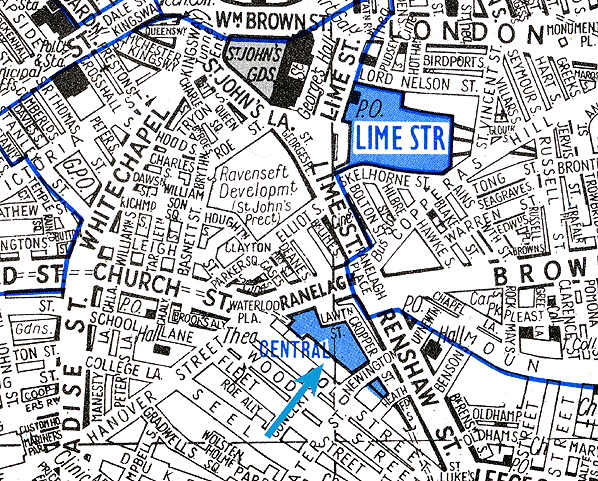
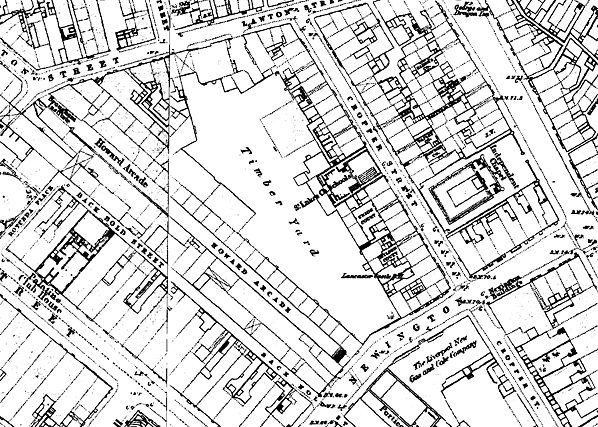
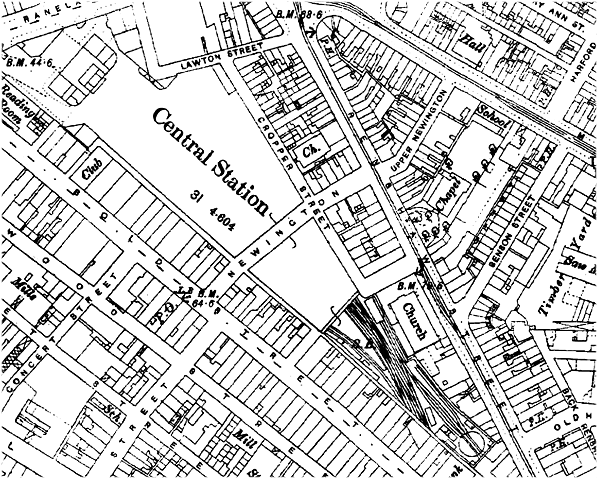
1850 1:500 OS Town Plan and 1893 1:2,500 OS map. By the 1870s central Liverpool was very built up, and being the ‘second city of the Empire’ land was at a premium. To buy property and demolish it was very costly even at that time. The CLC identified a site in the centre of the city that would require the demolition of few properties. The 1850 map shows the site had a large timber yard located on it. The open nature of the yard made the site ideal for the station. However the site was still small for a large city centre terminus, and, as a result, Liverpool Central was very cramped: there was no
room for future expansion.
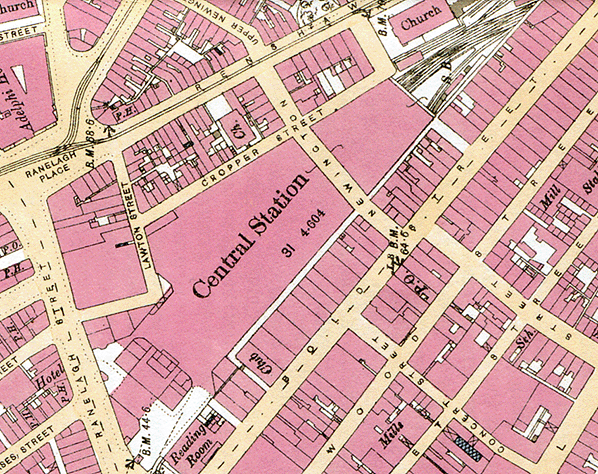
Liverpool Central shown on a 1:2,500 scale map from 1890.
central_old21.jpg)
A CLC service hauled by an LNER locomotive stands at platform 3 at Liverpool Central station c. 1940s. 2321 entered service for the GCR as No 1037 in May 1902. Built by Sharp Stewart to a Robinson design, this loco passed to the LNER and, classified D9 in 1924, it received the number 6037. Renumbered by the LNER in 1946 to 2321, this loco passed to BR and was again renumbered 62321 until it was withdrawn less than two years into BR ownership from 13E, Brunswick shed in October 1949 and cut up 2 months later.
Photo from John Mann collection
central_old.jpg)
The 7.30pm express service to Manchester central departs from Liverpool Cental in April 1950.
Photo by H C Casserley
central_old11.jpg)
Copyright photo by H C Casserley
central_old12.jpg)
Bootle, in June 1964.
Copyright photo by H C Casserley
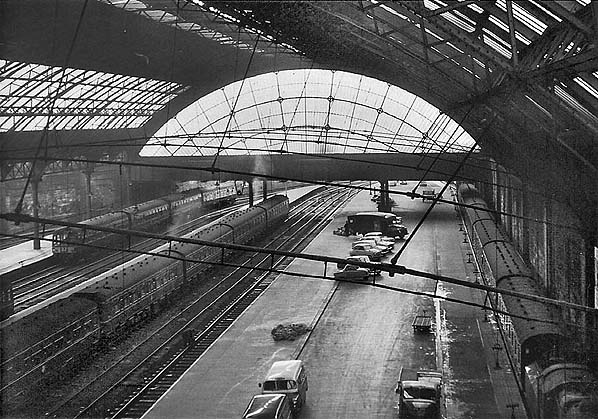
Looking into the train-shed at Liverpool Central from the Divisional Engineers office in 1965.
Photo by John Salter
.jpg) A view looking north at the site of Liverpool Central station on 30 March 2015.
A view looking north at the site of Liverpool Central station on 30 March 2015.Photo by Paul Wright
| Last updated: Sunday, 21-May-2017 14:31:43 CEST | © 1998-2015 Disused Stations |
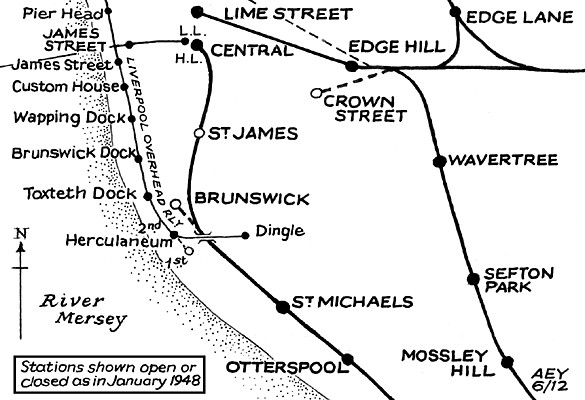
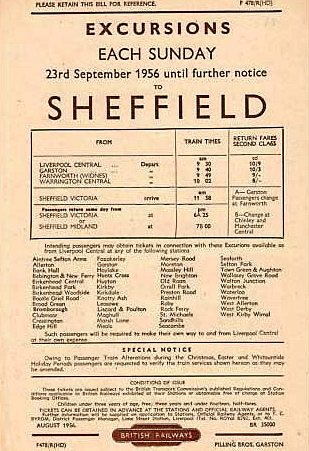 Liverpool Central station fronted onto Ranelagh Street which ran in an east/west direction at that point. The main entrance was through two imposing gates at the western end of Ranelagh Street at its junction with Church Street and with Bold Street. The gates were separated by a large sandstone column. Over the westernmost gate there was a sign that read ‘Central Station’. East of the gates was the large high-roofed single-storey parcels office. East of the parcels office was another set of gates and, beyond them, a building similar to the parcels office that housed refreshment rooms. Beyond the gates and behind the parcels office was an open area for cabs and other road traffic. Photographic evidence suggests that a one-way system for road traffic was implemented from quite an early date. The easternmost gates were for traffic entering the station, and the westernmost for departing traffic.
Liverpool Central station fronted onto Ranelagh Street which ran in an east/west direction at that point. The main entrance was through two imposing gates at the western end of Ranelagh Street at its junction with Church Street and with Bold Street. The gates were separated by a large sandstone column. Over the westernmost gate there was a sign that read ‘Central Station’. East of the gates was the large high-roofed single-storey parcels office. East of the parcels office was another set of gates and, beyond them, a building similar to the parcels office that housed refreshment rooms. Beyond the gates and behind the parcels office was an open area for cabs and other road traffic. Photographic evidence suggests that a one-way system for road traffic was implemented from quite an early date. The easternmost gates were for traffic entering the station, and the westernmost for departing traffic.  Behind the main building was a single arched trainshed of 164ft span which reached 65ft at its highest point. The station had three island platforms giving six platform faces. The longest and widest island platform was on the west side of the station, its west face numbered platform 1, and it was designated as the arrival platform. It had one line to serve it, and no run around facilities as the track was adjacent to the station’s western outer wall. The east face was platform 2 - the departure platform for long-distance services. Being wide the platform had a roadway along its centre for vehicles delivering or collecting merchandise. The platform extended beyond the trainshed at its southern end, but a roof covered it at that point almost to the ramp.
Behind the main building was a single arched trainshed of 164ft span which reached 65ft at its highest point. The station had three island platforms giving six platform faces. The longest and widest island platform was on the west side of the station, its west face numbered platform 1, and it was designated as the arrival platform. It had one line to serve it, and no run around facilities as the track was adjacent to the station’s western outer wall. The east face was platform 2 - the departure platform for long-distance services. Being wide the platform had a roadway along its centre for vehicles delivering or collecting merchandise. The platform extended beyond the trainshed at its southern end, but a roof covered it at that point almost to the ramp.  When the station opened only platforms 1 and 2 were ready so train services were confined to its western side; it was fully operational by 25 June 1874. At first there were sixteen trains per day to Manchester London Road. On 9 July 1877 the CLC opened a temporary Manchester Central station and from that date the Manchester services used it. An hourly express service was introduced on the same day that completed the journey in just over 45 minutes. The temporary Manchester Central was replaced with a permanent facility on 1 July 1880.
When the station opened only platforms 1 and 2 were ready so train services were confined to its western side; it was fully operational by 25 June 1874. At first there were sixteen trains per day to Manchester London Road. On 9 July 1877 the CLC opened a temporary Manchester Central station and from that date the Manchester services used it. An hourly express service was introduced on the same day that completed the journey in just over 45 minutes. The temporary Manchester Central was replaced with a permanent facility on 1 July 1880. By 1907 each of the CLC partners served London. The GCR ran trains to London Marylebone, the GNR to London Kings Cross and the MR to London St Pancras. The GNR service took over six hours, so it was hardly competitive with the LNWR services from Lime Street, and offered only one service per day. GCR services – one outbound and two returns - took a similar length of time. MR trains took four hours and twenty minutes which was still slower than the LNWR, but their trains were luxurious and so proved popular with passengers.
By 1907 each of the CLC partners served London. The GCR ran trains to London Marylebone, the GNR to London Kings Cross and the MR to London St Pancras. The GNR service took over six hours, so it was hardly competitive with the LNWR services from Lime Street, and offered only one service per day. GCR services – one outbound and two returns - took a similar length of time. MR trains took four hours and twenty minutes which was still slower than the LNWR, but their trains were luxurious and so proved popular with passengers.  On 1 January 1923 the railway companies of Great Britain were merged into four big concerns. The CLC and the Mersey Railway remained independent. The MR became part of the London Midland & Scottish Railway (LMS), the GCR and the GNR became part of the London & North Eastern Railway (LNER). The CLC became two-thirds owned by the LNER and one-third by the LMS. The LNER provided the motive power for CLC services.
On 1 January 1923 the railway companies of Great Britain were merged into four big concerns. The CLC and the Mersey Railway remained independent. The MR became part of the London Midland & Scottish Railway (LMS), the GCR and the GNR became part of the London & North Eastern Railway (LNER). The CLC became two-thirds owned by the LNER and one-third by the LMS. The LNER provided the motive power for CLC services. In 1959 and 1960 DMUs were introduced on many services from the main line platforms. For the Manchester Central service the four-coach DMUs had doors at all seats so passengers board or alight briskly at stations. Some services were improved with the introduction of the DMUs.
In 1959 and 1960 DMUs were introduced on many services from the main line platforms. For the Manchester Central service the four-coach DMUs had doors at all seats so passengers board or alight briskly at stations. Some services were improved with the introduction of the DMUs.  The MPTE was keen to promote rail travel in the Liverpool area and, building upon work carried out by its predecessors within the local Councils, it obtained an Act in 1971 to build new underground lines in the city centre and electrify existing routes. It branded the local rail network Merseyrail. One such route for electrification was from Liverpool Central towards Manchester. The proposals required a complete re-configuration at Liverpool Central so that a new underground loop line at a deep level and a link line at a sub-surface level could be constructed. The loop would serve trains that used the former Mersey Railway allowing them to pass through the city without reversing, and to serve more destinations. The link was designed to connect the former CLC system with the former L&Y network.
The MPTE was keen to promote rail travel in the Liverpool area and, building upon work carried out by its predecessors within the local Councils, it obtained an Act in 1971 to build new underground lines in the city centre and electrify existing routes. It branded the local rail network Merseyrail. One such route for electrification was from Liverpool Central towards Manchester. The proposals required a complete re-configuration at Liverpool Central so that a new underground loop line at a deep level and a link line at a sub-surface level could be constructed. The loop would serve trains that used the former Mersey Railway allowing them to pass through the city without reversing, and to serve more destinations. The link was designed to connect the former CLC system with the former L&Y network. 
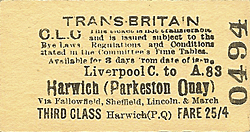

 Home Page
Home Page